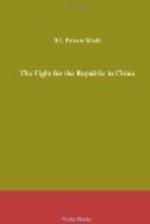There was none in China, at least none for the government. Financial chaos still reigned supreme in spite of the great Reorganization Loan of L25,000,000, which had been carefully arranged more for the purpose of wiping-out international indebtedness and balancing the books of foreign bankers than to institute a modern government. All the available specie in the country had been very quietly remitted in these troubled times by the native merchant-guilds from every part of China to the vast emporium of Shanghai for safe custody, where a sum not far short of a hundred million ounces now choked the vaults of the foreign banks,—being safe from governmental expropriation. The collection of provincial revenues having been long disorganized, Yuan Shih-kai, in spite of his military dictatorship, found it impossible to secure the proper resumption of the provincial remittances. Fresh loans became more and more sought after; by means of forced domestic issues a certain amount of cash was obtained, but the country lived from hand to mouth and everybody was unhappy. Added to this by March the formidable insurrection of the “White Wolf” bandits in Central China—under the legendary leadership of a man who was said to be invulnerable—necessitated the mobilization of a fresh army which ran into scores of battalions and which was vainly engaged for nearly half a year in rounding-up this replica of the Mexican Villa. So demoralized had the army become from long licence that this guerrilla warfare was waged with all possible slackness until a chance shot mortally wounded the chief brigand and his immense following automatically dispersed. During six months these pests had ravaged three provinces and menaced one of the most strongly fortified cities in Asia—the old capital of China, Hsianfu, whither the Manchu Court had fled in 1900.
Meanwhile wholesale executions were carried out in the provinces with monotonous regularity and all attempts at rising ruthlessly suppressed. In Peking the infamous Chih Fa Chu or Military Court—a sort of Chinese Star-Chamber—was continually engaged in summarily dispatching men suspected of conspiring against the Dictator, Even the printed word was looked upon as seditious, an unfortunate native editor being actually flogged to death in Hankow for telling the truth about conditions in the riverine districts. These cruelties made men more and more determined to pay off the score the very first moment that was possible. Although he was increasingly pressed for ready money, Yuan Shih-kai, by the end of April, 1914, had the situation sufficiently in hand to bring out his supreme surprise,—a brand-new Constitution promulgated under the euphonious title of “The Constitutional Compact.”




